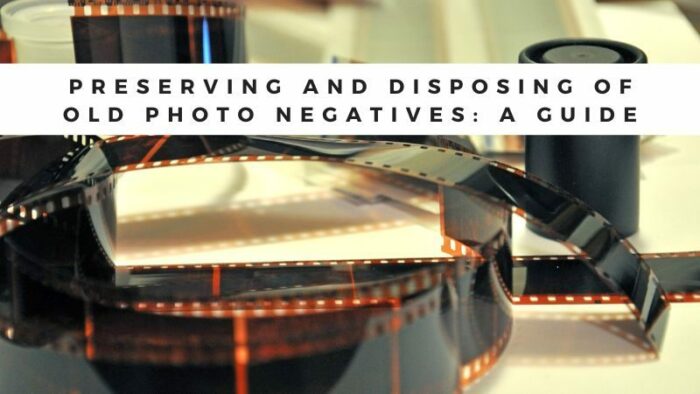Photo negatives are a type of film used in traditional photography to capture an image. They are made up of a light-sensitive material that reacts to light, producing a negative impression of the scene being photographed. This negative image is then used to create a positive image, or print, through printing.
So, can you throw away photo negatives? The answer is generally no, as they are an essential part of the photographic process and should be preserved. There are a few exceptions to this, however.
One exception is if the negatives are damaged or deteriorated beyond repair. If they are severely scratched, torn, or otherwise damaged, it may be necessary to dispose of them. However, keeping a record of the images captured on the negatives is still recommended, as they may still have sentimental or historical value.
Another exception is if you have multiple copies of the same negative. If you have a digital copy of the image or multiple prints made from the negative, it may be okay to dispose of the original negative. However, keeping at least one copy of the negative is still a good idea if something happens to the digital or print copies.
Overall, it is best to keep photo negatives as long as possible, as they are an essential part of the photographic process and can often hold sentimental or historical value. If you need to dispose of them, it is essential to do so carefully and keep a record of the images captured on the negatives.
Environmental Concerns of Throwing Away Negatives
Yes, there are environmental concerns with throwing away negatives. Negatives are made of a light-sensitive material, typically cellulose acetate or polyester, which can take hundreds of years to break down in a landfill. This means that they can contribute to the problem of plastic waste and litter in the environment.
In addition, negatives may contain chemicals, such as silver halides, which can leach into the soil and water supply if not disposed of properly. These chemicals can be harmful to plants and animals and can also contaminate drinking water sources.
Therefore, it is essential to dispose of negatives responsibly and in an environmentally-friendly manner. This may involve recycling them at a facility equipped to handle hazardous materials or donating them to a museum or historical society that can adequately preserve them. It is also a good idea to check with your local waste management company to see if they have any specific guidelines for disposing of negatives.
Hazardous Waste Facilities That Accept Negatives
Hazardous waste facilities may accept negatives, as they are made of a light-sensitive material and may contain chemicals such as silver halides. However, it is essential to check with the specific facility to see if they can accept negatives and if they have any guidelines or requirements for disposal.
In general, hazardous waste facilities are equipped to handle materials that may be harmful to humans or the environment if not disposed of properly. This includes chemicals, batteries, electronic waste, and other potentially hazardous materials.
If you are unsure whether a hazardous waste facility will accept negatives, it is a good idea to call and ask before bringing them in. You can also check with your local waste management company to see if they have any recommendations for eliminating negatives.
In addition to hazardous waste facilities, it is possible to recycle negatives at a film recycling facility or donate them to a museum or historical society that can properly preserve them. These options may be more suitable if the negatives are in good condition and still have sentimental or historical value.

Recycling Negatives
Yes, it is possible to recycle negatives. Negatives are made of a light-sensitive material, typically cellulose acetate or polyester, which can be recycled and repurposed into new products.
To recycle negatives, you can bring them to a film recycling facility or check with your local waste management company to see if they have any specific guidelines or recommendations for recycling negatives. Some facilities may accept negatives and other types of film, such as slides and movie films, for recycling.
Not all facilities may be equipped to handle negatives, as they may contain chemicals such as silver halides that require special handling and disposal. Therefore, it is a good idea to check with the specific facility to see if they can accept negatives and if they have any particular requirements or guidelines for recycling them.
In addition to recycling negatives, donating them to a museum or historical society that can properly preserve them is possible. This may be suitable if the negatives are in good condition and still have sentimental or historical value.
Preserving Negatives
There are several steps you can take to preserve photo negatives:
- Store negatives in a cool, dry place. Avoid storing negatives in damp or humid conditions, as this can cause them to degrade over time.
- Keep negatives away from direct sunlight. Exposure to sunlight can cause negatives to fade or become discolored.
- Handle negatives carefully. Avoid touching the emulsion side of the negative with your fingers, as the oils on your skin can damage the negative over time. If you must handle negatives, use clean, dry hands or wear cotton gloves.
- Use acid-free storage materials. Negative sleeves, envelopes, and boxes made from acid-free paper or plastic are the best choice for storing negatives long-term. These materials are less likely to cause deterioration or discoloration of the negatives.
- Keep negatives in a protective container. A sturdy box or album with a tight-fitting lid can help protect negatives from damage.
- Make digital copies of significant negatives. Digital copies of negatives can be made using a scanner or a digital camera. This will provide an additional copy of the image that can be shared or printed, while the original negative can be stored in a safe place.
Following these steps can preserve your photo negatives for many years.
Conclusion
Photo negatives are essential to traditional photography and should be preserved whenever possible. At the same time, it may be necessary to dispose of negatives in certain situations, such as if they are damaged or deteriorated beyond repair, it is generally a good idea to keep them as long as possible.
There are also environmental and hazardous waste concerns to consider when disposing of negatives, as they are made of a light-sensitive material and may contain chemicals such as silver halides. Therefore, it is essential to dispose of negatives responsibly and environmentally friendly, such as recycling them at a film recycling facility or donating them to a museum or historical society. Overall, it is best to keep photo negatives as long as possible, as they can hold sentimental or historical value and are an essential part of the photographic process.

